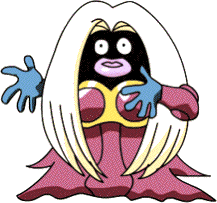Kris Bayne
Stereotyping: Pokemon Jynx #124

Background
The issue of stereotyping is perhaps the 'mildest' form of racism or discrimination. Stereotyping is the
application of certain traits and behaviours, sometimes physical, sometimes behavioural, sometimes cultural.
According to one definition "Stereotypes are those overgeneralised and oversimplified beliefs we use to
categorize a group of people . . . Stereotypes may be based on the truth, but they are exaggerated statement
regarding our belief about what a group of people are or should be" (Chen and Starosta, 39). We can hold
these beliefs quite innocently. Also, while some stereotypes of a group might be favourable or at least
not unfavourable, such as, "Japanese are polite", many are negative and offensive.
Pokemon is a worldwide favourite with children. Of the 150 Pocket Monsters there are very few that look human
at all. One that does is Jynx (#124). Jynx has many stereotypical features that are offensive to people of
African descent. Some of Jynx's physical features include black skin, large pink lips, wide-open eyes: all
these being very offensive and 'traditional' stereotypes applied to people of African descent, either
from Africa or African-Americans, for example.
Why I Chose This Example
I chose this topic because the drawing activity provided some interesting examples from the class, and the
'Mr. Wong' activity showed how such stereotypes can be misused for humour. I also have children who used to
watch Pokemon. Unfortunately, it is in children's stories and videos (such as Disney movies) that we can
still find such stereotypes of certain groups. "Little Black Sambo" was an infamous example which has
now been 'removed', however many more instances exist. As adults we must examine our own stereotypes and
think carefully before we unwittingly pass them on to the next generation.
Works Cited
Chen, G. H. & Starosta, W. (1998). Foundations of Intercultural Communication. Boston.: Allyn & Bacon.
Weatherford, C. B. (2000). Japan's bigoted export to kids. Retrieved 11 May 2002 from www.csmonitor.com/durable/2000/05/04/p9s1.htm.
|
